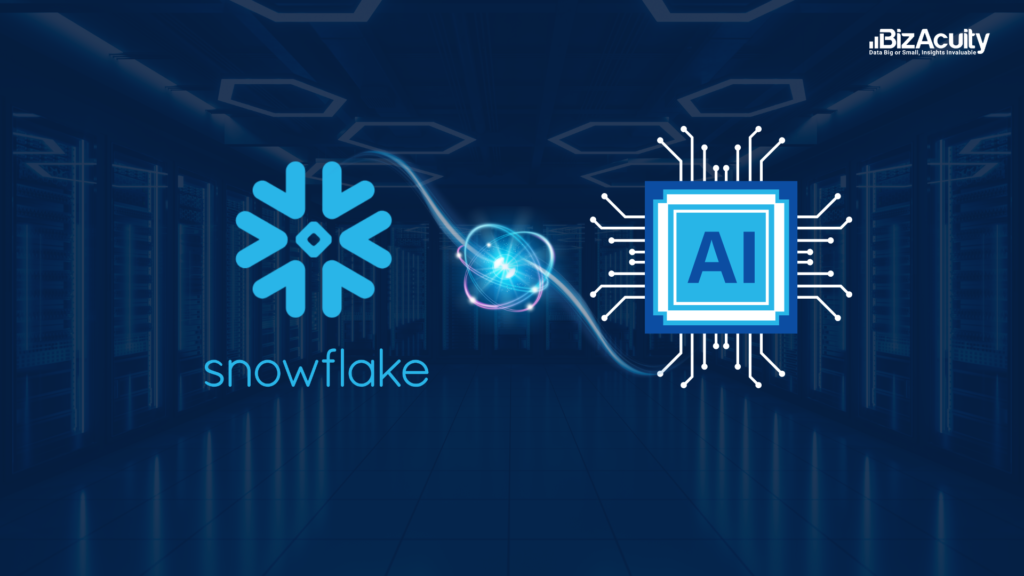Artificial intelligence is no longer a far-off aspiration. It has become the foundation for how modern businesses make decisions, engage customers, and stay competitive. Many enterprises have invested in AI and machine learning, yet they face a crucial challenge: making these models work in everyday operations.
For most, the bottleneck isn’t tools, it’s operationalizing AI at scale. Moving from standalone models or proofs of concept to a robust, integrated analytics environment is far more complex than it appears.
If your organization already uses Snowflake, you might be closer to that goal than you think. Originally designed as a cloud-native data warehouse, Snowflake has evolved into a unified data platform where machine learning, data engineering, and business intelligence converge. Its growing AI capabilities mean enterprises can accelerate the shift from traditional BI to advanced, predictive analytics.
From Traditional BI to AI-Driven Analytics
Traditional business intelligence still dominates many enterprise data practices. Data is pulled, cleaned, and visualized on dashboards, usually to interpret historical trends and guide decisions reactively. While that’s useful, it rarely supports forward-looking decision-making at the pace markets demand.
That’s where Snowflake AI capabilities come into play. Predictive and prescriptive analytics can forecast demand, predict churn, or catch fraud in real time — but only if the right foundations exist. Successful organizations need platforms where models are built, deployed, and governed alongside their core data pipelines, eliminating the typical gaps between data and decision-making.
Snowflake AI Capabilities at a Glance
Over the past few years, Snowflake has added powerful tools and features to support the entire machine learning lifecycle. These innovations help data teams move from experimentation to production at scale:
- Snowpark: Write transformations and machine learning logic in Python, Scala, or Java, all running natively within Snowflake to avoid unnecessary data movement.
- Native Python Support: Simplify MLOps by running Python-based models with libraries like Pandas, scikit-learn, and TensorFlow directly inside Snowflake.
- External Functions: Securely call third-party services such as AWS SageMaker or Azure ML while keeping orchestration and governance in Snowflake’s environment.
- Streamlit Integration: Quickly build and deploy interactive apps to share machine learning insights with business users, without managing separate web infrastructure.
- Snowflake Marketplace: Gain access to curated, ready-to-use external datasets to enrich your models and accelerate AI development.
- Snowflake Cortex: A prebuilt framework for large language models (LLMs) and advanced ML functions — including sentiment analysis, document classification, and summarization — available directly through SQL.
- Snowflake ML: Supports native model training without data leaving Snowflake, improving speed, security, and compliance.
- Snowflake Model Registry: Provides model versioning, storage, and governance, ensuring your MLOps processes are consistent and scalable.
- Snowflake Notebooks: Allow data scientists to work directly in interactive Python notebooks within the Snowflake UI, keeping experimentation and production close together.
- LLM Functions & Vector Search: Native support for embedding models, similarity search, and retrieval-augmented generation (RAG) on enterprise data.
These features together position Snowflake as a true enterprise-grade AI hub, supporting everything from predictive forecasting to generative use cases at scale. These advances aren’t just theoretical. For example, Intercontinental Exchange (ICE) — which operates the New York Stock Exchange — has adopted Snowflake’s Cortex AI features for regulatory reporting and market surveillance. Processing over half a trillion messages per trading day, they reduced reporting workloads by 50% while improving ad hoc query performance by 80%, enabling faster anomaly detection and stronger oversight.
Closing Gaps Between AI and Outcomes
Of course, technology alone is rarely the full answer. Many enterprises still struggle to make Snowflake’s machine learning features deliver real, sustained results because their AI initiatives operate in isolation — disconnected from data governance, BI pipelines, or production applications. Some common roadblocks include:
- Fragmented architecture
Separate systems for pipelines, models, and reporting tools can leave predictions stuck in silos. - Missing MLOps discipline
Without proper model governance, versioning, and monitoring, prototypes never scale beyond the lab. - Lack of integration
Even the most accurate models cannot drive value if they aren’t connected to business workflows.
Enterprises that succeed treat AI on Snowflake as a continuous practice, not a one-off project. They invest in data structures that integrate historical and real-time signals, establish robust MLOps frameworks, and embed predictions into applications and dashboards so decisioning loops stay tight and repeatable.
Why It Matters Now
The move toward AI-first decision-making is accelerating. Waiting risks falling behind — not just in technology, but in the ability to respond to change, serve customers effectively, and unlock new opportunities.
Snowflake’s AI capabilities are positioning it at the center of this shift — not just as a place to store data, but as a true platform for building intelligence on top of it. But technology is only one side of the equation. Enterprises need a deliberate strategy, repeatable processes, and the right architecture to go from pilots to production at scale.
If you’re looking to move beyond traditional BI and unlock the full potential of AI on Snowflake, there has never been a better time to act. The tools are mature, the ecosystem is vibrant, and real-world success stories show what’s possible.



